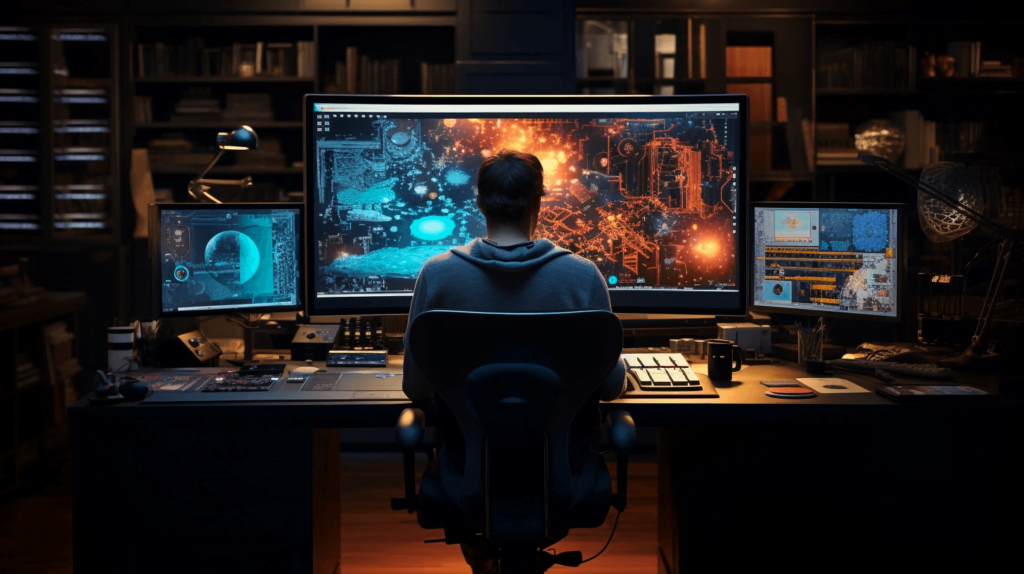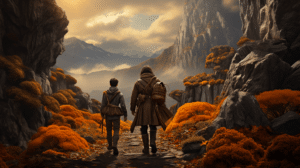In today's digital world, design plays a pivotal role, not just as a means of capturing the audience's attention, but also as an essential tool to enhance user experience and strengthen brand identity. As we navigate through websites, apps, and digital platforms, we are constantly influenced by design, often without even realizing it. However, this design is not a singular, homogeneous field, but a spectrum of disciplines with distinct focuses and objectives. Among these disciplines, Graphic Design and UX/Product Design are often mentioned.Mas qual é a real diferença entre essas duas disciplinas?
Graphic Design, traditionally rooted in visual arts, focuses on aesthetics and visual communication. It encompasses the creation of visual elements such as logos, layouts, typography, and images, all aimed at conveying messages and values in an appealing and impactful manner.
On the other hand, UX/Product Design (User Experience/Product Design) is a more user-centered discipline, focused on optimizing the experience of a product or service. Here, functionality and usability take center stage. The goal is to create solutions that are not just visually appealing, but also intuitive, accessible, and enjoyable for the end user.
In this material, we will explore together the differences between these two vital fields of design, with a special look at how they interact and differ in terms of aesthetics and functionality. As we delve into this debate, we seek to understand how the balance and collaboration between aesthetics and functionality can lead to more complete and effective design solutions, both for users and for brands.
Graphic Design and UX & Product Design: Where Do They Come From and What Do They Stand For?

To fully understand the differences and intersections between Graphic Design and UX/Product Design, it's essential to explore their origins, evolutions, and main focuses.
Graphic Design: An Essential Pillar of Advertising
Graphic Design, as we know it today, has its roots in visual communication dating back to ancient times, but it gained its own identity with the advent of the printing press and, later, with the industrial revolution.
It evolved from simple advertisements and prints to a complex discipline encompassing a variety of mediums and techniques. In the 20th century, graphic design became an indispensable part of advertising and marketing, helping brands to communicate their messages effectively and visually appealingly.
The main focuses of Graphic Design include:
- Aesthetics: Creating visually appealing pieces that capture attention and convey messages effectively.
- Visual Identity: Developing coherent visual elements that represent a brand's personality and values.
- Communication: Using images, typography, and colors to convey information and emotions, establishing a visual dialogue with the audience.
UX & Product Design: The Focus on User and Experience
UX/Product Design has its roots in industrial design and ergonomics, but really began to take shape with the rise of the digital era.
The need to create digital products that were not only functional but also enjoyable and easy to use made this discipline stand out. With the explosion of the internet and the proliferation of mobile devices, UX/Product Design became essential in creating digital experiences that meet user expectations.
The main focuses of UX/Product Design are:
- Usability: Ensuring that products are easy to use and understand.
- User Experience: Creating products that offer enjoyable, efficient, and memorable experiences.
- Functionality: Focusing on developing products that not only meet user needs but also exceed their expectations in terms of performance and utility.
Aesthetics vs. Usability: Where is the Balance?

In this section, we will explore the dynamic interaction between aesthetics and usability, two fundamental elements in the world of design, which, although distinct, can and should complement each other.
When thinking about Graphic Design and UX/Product Design, we may tend to see these two disciplines separately, as different areas that operate in different places.
However, this separation is not so clear-cut. The aesthetics of Graphic Design and the usability of UX/Product Design, while seeming distinct, can and should complement each other.
The big question is: how to find this balance?
The Importance of Aesthetics in Graphic Design
In Graphic Design, aesthetics is not just a component; it is the heart of the discipline. A visually attractive design can capture attention, establish emotional connections, and communicate brand values more effectively.
For example, think of iconic brands like Apple or Coca-Cola. Their visual identity is not just recognizable; it evokes specific feelings and associations. The choice of colors, typography, and imagery in graphic design plays a crucial role in how a brand is perceived and remembered.
Therefore, thinking about Graphic Design is also thinking about brand strategy, its positioning, its identity, and how it communicates with its audience. Hence, it is indeed very important for products and companies.
Usability is Key in UX and Product Design
While aesthetics dominate the field of graphic design, usability is the cornerstone of UX and Product Design.
An intuitive user interface, a well-designed user journey, and ease of interaction not only increase user satisfaction but can also lead to better conversion rates and brand loyalty.
A good example is the streamlined design of apps like Airbnb or Uber, where usability is maximized to ensure a smooth, effortless user experience, facilitating the tasks users want to accomplish.
Therefore, in the digital age we live in, it's not enough to just think about aesthetically pleasing elements. It's essential to think about the user and how they interact with your product, prioritizing their experience and journey.
Balancing Aesthetics and Functionality
True mastery in design arises when aesthetics and functionality intertwine harmoniously.
To achieve this, designers from both disciplines need to collaborate and learn from each other. A website can look amazing, but if users find it difficult to navigate, its value diminishes. Similarly, an app can be extremely functional, but if it's visually unappealing, users may not feel engaged.
Graphic designers and UX and Product Designers can work together to create experiences that not only look great but are also exceptionally usable. This balance is key to successful projects that please and retain users.
Additionally, it is very common for graphic designers to want to transition into the product area, becoming UX and Product Designers. In these cases, professionals who already have well-established graphic design concepts, incorporate user-centered design knowledge, thus becoming more complete professionals who can navigate more easily between aesthetics and functionality.
However, if you don't have a background in design but want to work in UX and Product Design, don't worry! It's not necessary to have design experience to transition into UX. Many of our students did not come from this background. The important thing is to have the will and dedication to studies, and then the transition and growth in the field happen in a matter of time.
Reading Tip: Do I Need a Design Background to Switch to UX?
Tips: What to Consider in Product Development?
Developing products that are aesthetically pleasing and offer a smooth, frictionless experience is a challenge for any design team.
To achieve the best results in your project, balancing aesthetics with functionality, consider the following issues:
- Balance between aesthetics and functionality: It's crucial to maintain a balance between visually attractive design and an intuitive, accessible user experience.
- User feedback is essential: User testing and continuous feedback are fundamental in identifying and fixing usability issues.
- Flexibility and adaptability: Designers must be willing to adjust or redesign design elements based on functionality and user experience.
- Collaboration between disciplines: Collaboration between graphic designers and UX/Product designers is vital to create solutions that are both attractive and functional.
The Influence of Brand on UX Design

The relationship between a brand's visual identity and user experience is a fascinating and complex dynamic, where each element has the power to significantly influence the other.
A brand's visual identity goes far beyond the logo or color palette; it encapsulates the essence of the brand, its values, and personality. When this visual identity is well integrated into the user experience, it creates a deeper and more meaningful connection with the audience. An interface design that reflects the brand's identity can strengthen customer perception and loyalty, as well as provide a more cohesive and memorable experience.
For example, by integrating consistent visual elements, such as colors, typography, and imagery style, an app or website not only strengthens the brand identity but also helps users intuitively navigate the interface. This alignment between branding and UX is crucial for conveying trust and professionalism, making users feel more secure and comfortable when interacting with the product.
Examples of Success
There are several brands that exemplify the success of this integration between aesthetics and functionality:
- Apple: Apple is often cited for its ability to combine aesthetics and functionality. Its products and user interfaces are known for their minimalist, intuitive, and aesthetically pleasing design, reflecting the brand's philosophy of simplicity and innovation.
- Airbnb: Airbnb revamped its visual identity and user interface, focusing on simplicity, ease of use, and an aesthetic that reflects hospitality and adventure. The result is a user experience that not only looks good but also facilitates the search and booking of accommodations.
- Spotify: Spotify offers a user experience that is as vibrant and dynamic as the variety of music it offers. The intuitive design, along with a strong and interactive visual identity, creates an immersive experience that resonates with its target audience.
Current and Future Trends
The world of design is constantly evolving, driven by new technologies, changing user expectations, and the emergence of new trends. Let's explore some of the latest innovations in Graphic Design and how UX/Product Design is adapting to these new realities:
- Inclusive and Accessible Design: A growing focus on creating designs accessible to all users, including those with disabilities. This involves the use of contrasting colors, legible typography, and consideration for different types of visual and cognitive disabilities.
- Augmented and Virtual Reality: The integration of AR and VR elements in graphic materials is creating immersive and interactive experiences for users, opening new frontiers for storytelling and product presentation.
- Sustainable and Eco-friendly Design: With a growing interest in environmental issues, graphic designers are exploring ways to create designs that are not only visually attractive but also eco-friendly, using sustainable materials and reducing digital waste.
- Human-Centered and Ethical Design: An approach that places the needs and well-being of users at the center of the design process. This involves deeply understanding user behavior, their needs, and how they interact with digital products.
- Artificial Intelligence and Machine Learning: The integration of AI and machine learning is transforming how we understand and design the user experience. This includes everything from personalized chatbots to adaptive interfaces that learn and adjust to user preferences.
- Design for Wearable Devices and IoT: With the rise of wearable devices and the Internet of Things (IoT), UX/Product Design is expanding beyond traditional screens, creating integrated experiences that extend across multiple devices and usage contexts.
Throughout this content, we have explored the nuances and intersections between Graphic Design and UX/Product Design, two fundamental fields in the universe of digital design.
We have seen how Graphic Design, with its focus on aesthetics and visual communication, plays a crucial role in creating attractive and memorable brand identities. In parallel, UX/Product Design, with its emphasis on usability and functionality, ensures that products not only look good but also offer exceptional user experiences.
The final reflection is clear: understanding the differences and synergies between Graphic Design and UX/Product Design is essential for any professional who wishes to create effective and engaging digital solutions.
Collaboration and mutual learning between these two disciplines can lead to products and services that not only satisfy the eyes but also provide rich and intuitive experiences.
As we continue to navigate an increasingly digital world, the ability to combine aesthetics with functionality will become even more critical, defining the success of design projects in the future.








